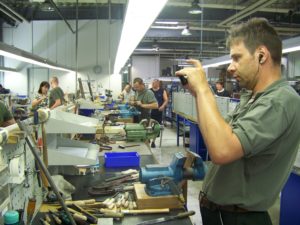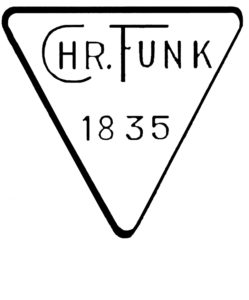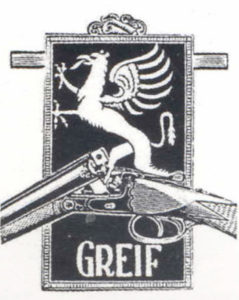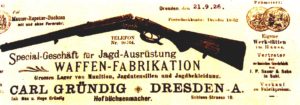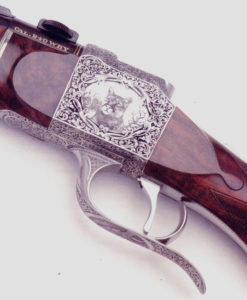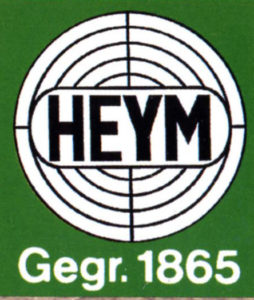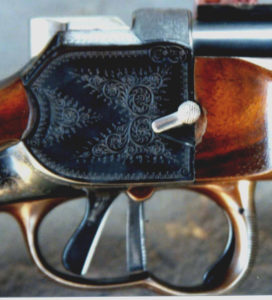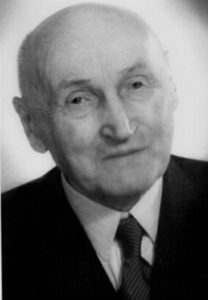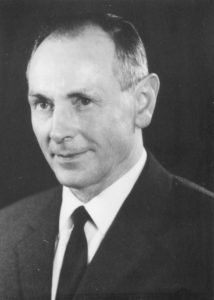Gun Manufacturers – Gun Makers and Engravers
Gun Dealers and Gun Shops
both former and today’s in alphabetical order.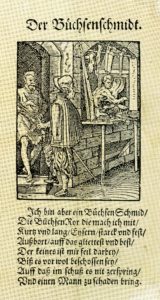
Former Gun Manufacturers, Gun Makers and Engravers, Gun Dealers and Gun Shops
that made or sold German Hunting Guns
| It is not easy to decide when a gun maker becomes a gun manufacturer. Most of the bigger gun manufacturers had their beginning as small shops with a few gunsmiths and stock makers that bought raw components from factories and had work done by other shops that specialized in certain work. It is also difficult to be sure of who actually made a gun, because the name on the gun might be that of the dealer who sold the gun and either bought or ordered it from a gun maker.
Most gun dealers had their own gun shops mostly for doing repairs, but bigger ones also finished partly finished guns that were purchased from other gun makers in Germany, Belgium and other countries and even England. The major manufacturers had their own engraving departments that also trained new engravers. Some of the more experienced engravers had their own shops next to or in their homes and did the more elaborate engravings for the factories. Unfortunately, not even the master engravers who did the most elaborate engravings were allowed to sign their work, and identifying the engraver on an older gun is very difficult if not impossible. It must also be mentioned that most of the older German hunting guns had some engraving, even on the least expensive models. |
Today’s Gun Makers, Engravers and Dealers of German Hunting Guns
Most of the traditional bolt-action rifles and combination guns are still made today, but the following changes and trends are apparent:
Prices of German factory made guns are in general higher than equal models in the United States but usually offer more custom features. Guns made to order by some factories and the smaller makers are as a rule quite expensive, but not nearly as pricey as best English guns.
Bolt Action Rifles made in the bigger factories have mostly switched to designs that have the bolt lock directly into the breech end of the barrel, a design that was patented by Louis Schlegelmilch at the Spandau Arsenal in 1889. This design makes it possible to quickly install a barrel in a different caliber, on some without the use of any tools. These rifles are also very suitable as takedown rifles that today’s world traveler appreciates.
Very fine custom-built bolt-action rifles are available from various smaller makers that cater to all wishes a customer might have. Most use Mauser 98 type actions, but declining numbers of military surplus actions. Instead, they tend to choose reproduction Mauser actions with custom features like square bridge receivers, hinged floor plates, three position side-swing safeties and a great variety of scope mounts, including the German claw mounts. They are made for the lightest to the very heaviest big bore calibers.
New safeties and triggers for bolt action rifles are designed for greater reliability, where wing safeties are locked in the safe position and single set-triggers un-cock themselves when the bolt is opened. One of the latest designs has a separate cocking mechanism built into the bolt that allows the rifle to be carried in an un-cocked condition and cocked quickly when ready to shoot.
Drillings and Combination Guns are still available in the various barrel configurations of the older German guns. However, there is considerable improvement in strength of the actions and barrels through the use of modern steels, allowing heavy magnum calibers. Old and proven strong locking devices that were very expensive in the good old times have been re-discovered and can be produced more economically on modern computer-controlled machining centers.
A big bore African caliber can now be combined with a 3”-20 Ga, shotgun barrel, giving the dangerous game hunter an additional shot with a rifled slug that has stopping power. Many of the trigger mechanisms are now much safer because of the separate cocking features. Another major improvement are floating rifle barrels.
The owners of traditional, older guns know that the impact of the rifle bullet will climb as the rifle barrel on a soldered barrel assembly gets hot. A floating rifle barrel on modern Drillings prevents this. A built in regulating mechanism at the muzzle of a double rifle Drilling makes regulation and re-regulation a whole lot easier and will not require rebluing of the barrels. It must be said, however, that the appearance of some modern Drillings when compared to the old timers has suffered, but beauty is in the eye of the beholder.
Vierlings are still made but are hard on your pocket book. They usually give you an additional small caliber rifle barrel that is located in the top rib or between the shotgun barrels. The lock mechanism is much more complicated, weight must be a consideration and the use of an aluminum receiver might be advisable, except for very heavy calibers.
Double rifles are offered by the Blaser, the Heym and the Krieghoff Companies and by the few remaining small makers in Suhl. Better steel, stronger locking mechanisms, barrel regulation devices and separate cocking mechanisms make these guns very practical and reliable for the big game hunter. The Ziegenhahn Company in Zella-Mehlis can build a fine box lock or side lock double rifle that compares very favorably with the best made in the world.
Traditional German over and under shotguns are still made in the traditional way by the Merkel company and by a few small makers in Suhl, using the Kersten locking mechanism and minor improvements.
Max Ern makes over and under guns with a unique rising bite bolting system.
The Krieghoff K-80 over and under shotgun, developed and improved from the Remington Model 32, has captured a great following for use in the field, for skeet, trap and sporting clays. The Krieghoff Company also offers a custom round action side lock shotgun in various calibers that found instant acclaim.
Merkel makes a wide selection of traditional side-by-side and over and under shotguns, both as box lock or side lock guns in various grades, models and calibers.
When it comes to Air Rifles, German-made rifles win most medals in international competition, including the Olympics. Hartmann & Weiss and Schilling make single shot rifles on falling block actions.
| Abesser & Merkel, formerly in Suhl
Adamy in Suhl Adolph, Fred formerly in USA AKAH – Kind in Hunstig, Germany Ansorg, formerly in Zella-Mehlis Barella, formerly in Berlin-Germany Bartels, formerly in Zella-Mehlis Behr, Burkard & Behr’s Waffen-Werke of Bremen & Suhl Bock, Otto- Berlin Brenneke Guns and Ammunition BÜHAG, Bühag (Buehag) Cooperative in Suhl Daly, Charles in New York Dreyse, Nicholaus von Dreyse and sons Ern, Max in Leverkusen,-Germany Eyring in Suhl Förster –W. Foerster in Berlin Frühauf, Hendrik in Breitenbach near Suhl Funk, formerly in Suhl Greifelt in Suhl Gründig, Carl in Dresden Hagn, Martin in Cranbrook-Canada Hartmann & Weiss in Hamburg-Germany Heym, Friedrich Wilhelm in Suhl, Münnerstadt, Gleichamberg Jaeger, Franz formerly in Suhl
|
Jaeger, Kurt formerly in Suhl and Mainz
Jaeger, Paul formerly in Jenkintown, Pa. Kersten, Gustav in Strassburg Kettners, Eduard & Franz Kind in Hunstig, Germany Krieghoff, in Germany and USA Kuchenreuter, A Gunmaking Dynasty Lindner, H.A. in Suhl Meffert, Imman. in Suhl Merkel, Bernhard in Suhl Merkel, Ernst August in Suhl Merkel, Oskar in Suhl Merkel, Paul Ernst in Suhl Merkel Brothers (Gebrüder Merkel) in Suhl Oberhammer, Peter of Munich Prechtl in Birkenau-Germany Rasch, George L. & Christof W. in Braunschweig Reeb, J.J. Reeb Company in Bonn Rempt, formerly in Suhl Sauer, J.P. & Co. formerly in Suhl Sauer, J.P. in Eckernförde and Isny Scherping, Heinrich- Hannover Schilling in Zella-Mehlis Schiwy, Ludwig in Berlin Simson Suhl-BSW-WAFFA-Gustloff Werke Stendebach, C.F. in Germany Stiegele, formerly in München, Germany Steigleder, Ernst of Berlin & suhl Thieme & Schlegelmilch, formerly in Suhl Willig in Schweinfurt, Germany Ziegenhahn, formerly in Suhl, now in Zella-Mehlis |
In the alphabetical list that follows we combine the listings of German Breech Loading Hunting Gun Makers and Dealers, both former ones as well as those still in business today. This list will eventually be very long, especially the one about former Gun Makers. We will concentrate our efforts on those makers and dealers where good information is available.
To find a dealer or gun maker by first name or company name, scroll down through the alphabetical listings.
To open additional information, articles and photos in our archive about a certain maker or dealer, click on Archive.
Stop back to see new listings that will be added as quickly as we can and as new information becomes available. Additions and corrections are welcome.
F to J
Förster – Foerster
Wilhelm K. Förster in Berlin
Master Gunsmith and Gun Dealer
Hofbüchsenmacher (Gunsmith to the Court)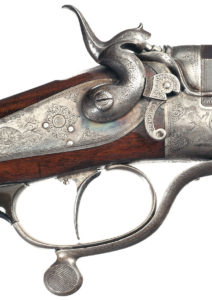
Hofgewehrfabrik (gun factory to the Court)
Supplier to the Royal Court of Carl of Prussia, a son of King Friedrich William III of Prussia, and also to the Russian Tsars.The Förster business was founded in 1861 and had facilities in these two locations: Berlin W 8, Taubenstr.47 and a branch in Berlin W 30, Mozarstr.61. The company was last mentioned in 1920 as a member of an Association of Gun Makers and Dealers., possibly with a new owner.The Foerster side-by-side hammer shotguns, double rifles and stalking rifles we have seen over the yeas are outstanding in every respect. They are all very slim and nicely shaped. The bolt action rifles were mostly built on Mauser 98 actions, and they are also very slim and elegant look, all with fine engraving.In the early years Foerster most likely made most of his guns in his shops in Berlin, but may have used other small gun makers and engravers who  did the work in their own shops. Unfortunately we have no information about them. There is however proof that in later years he had ordered a great variety of guns from various gun makers in Suhl. The next to last guns shown in the photo gallery in our archive is a double rifle made by the Heym Company in Suhl.The guns with the “Clamshell Action” (Muschel Verschluss or Stabil Verschluss) could have been made by several makers, among them Robert Schüler (RS) in Suhl, the inventor, Gebrüder Merkel (GM) in Suhl, Oskar Merkel in Suhl (Merco) and Bernhard Merkel in Suhl (Bemesu). All were of best quality and some had the maker’s mark that is shown above after their name on the underside of the barrels.Foerster guns are now very desirable to gun collectors and bring very high prices when sold by good auctioneers like Julia in Maine.The action
did the work in their own shops. Unfortunately we have no information about them. There is however proof that in later years he had ordered a great variety of guns from various gun makers in Suhl. The next to last guns shown in the photo gallery in our archive is a double rifle made by the Heym Company in Suhl.The guns with the “Clamshell Action” (Muschel Verschluss or Stabil Verschluss) could have been made by several makers, among them Robert Schüler (RS) in Suhl, the inventor, Gebrüder Merkel (GM) in Suhl, Oskar Merkel in Suhl (Merco) and Bernhard Merkel in Suhl (Bemesu). All were of best quality and some had the maker’s mark that is shown above after their name on the underside of the barrels.Foerster guns are now very desirable to gun collectors and bring very high prices when sold by good auctioneers like Julia in Maine.The action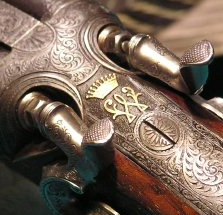 shown on the right has a monogram with a crown and a gold inlayed W is on a Foerster double rifle hammer gun. The owner hoped that this double rifle could have been made for Kaiser Wilhelm, but a crown with 9 tines indicates that it was made for a count. The next photo on the right shows an Austrian carbine with a Steyr action and a monogram with a crown above the W that was definitely made for the King or Kaiser Wilhelm. The hammer gun has a cross-over stock for use by a right-hand shooter aiming with the left eye. Since it is known that Kaiser Wilhelm had a crippled left arm, this could have supported the hope that this gun was made for Kaiser Wilhelm, but a cross-over stock was not what he could
shown on the right has a monogram with a crown and a gold inlayed W is on a Foerster double rifle hammer gun. The owner hoped that this double rifle could have been made for Kaiser Wilhelm, but a crown with 9 tines indicates that it was made for a count. The next photo on the right shows an Austrian carbine with a Steyr action and a monogram with a crown above the W that was definitely made for the King or Kaiser Wilhelm. The hammer gun has a cross-over stock for use by a right-hand shooter aiming with the left eye. Since it is known that Kaiser Wilhelm had a crippled left arm, this could have supported the hope that this gun was made for Kaiser Wilhelm, but a cross-over stock was not what he could 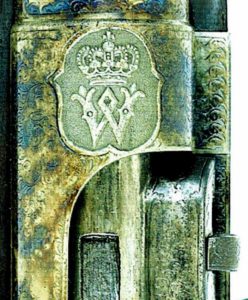 have used. The surprising similarity of the gold inlaid W on both guns is also remarkable, but it was definitely not for Kaiser Wilhelm.Among his later hunting rifles were bolt action rifles with Mauser 98 actions, and the company also became a representative of the Mauser Company.Foerster also had a hand in the development of these cartidges:10x47R Foerster (DWM # 31A) a black powder cartridge
have used. The surprising similarity of the gold inlaid W on both guns is also remarkable, but it was definitely not for Kaiser Wilhelm.Among his later hunting rifles were bolt action rifles with Mauser 98 actions, and the company also became a representative of the Mauser Company.Foerster also had a hand in the development of these cartidges:10x47R Foerster (DWM # 31A) a black powder cartridge
9 x 74R Foerster (DWM # 474) a forerunner of the 9.3x74R
6 x 58 R Foerster (DWM # 489)
6 x 58 R Foerster (DWM # 489A) both similar to 6mm Lee Navy or 6mm Rem.Since it is said that a photo is worth a thousand words, you can see very good photos of Foerster guns in our Archive (Nr.41-PG ).e
Fruehauf, Hendrik
Hendrik – Master Engraver 
Kiesweg 13
D-98553 Breitenbach – Germany
Tel.:+49 (0) 36841 – 43. 582
Mobile: +49 (0)171 – 34. 33. 013
hf@gebrueder-fruehauf.de
http://www.gebrueder-fruehauf.de/Hendrik learned his trade in Suhl while Germany was located behind the iron curtain. When the wall came down and Germany was re-united, he finally had access to the work of other engravers in England, Italy and the USA and has met some of them. This widened his horizon and it did not take long before his talents were discovered. He is now ranked among the best of German and Austrian engravers. See some of his work in our Archive (Nr. 57-PG).
Funk Gun Makers in Suhl
Christoph Funk Gewehrfabrik
Göthaer Str. 18, SuhlFounded in 1835 by Joseph Christoph Funk.1852 First serial production of percussion-drillinge for US market
1861/62 US Rifle Muskets for the American Civil War
1874 Founder dies. Successors are 2 sons: Albert and Oscar Funk
1901 Launch of “Funk Geschoss” (cartridge)
1904 Patent on safety for drillings
1914 Ernst – son of Oscar Funk – joins the company and becomes sole owner 1920
1933 Funk starts to make actions of Spezial-Einsatz Stahl
1935 Launch of Jubiläums-Drillinge
Launch of “Funk-Gerl-Zwomantel Geschoss” – a super-bullet of the 1930’s.
1936 Patent on combined 2-barrel Mauser-rifle
1945 Company is closed. All machinery is taken to the Soviet-Union
1945-46 Company name is changes to Feinmessgeräte und Gewehrfabrik Funk
Small production of side-by-side guns is carried on by Ernst Funk
1949 The “Bühag” takes over sales and distribution {gun maker cooperative)
1959 Gun production endsProduction approx. 38,500 units
Very broad production range in hunting guns.
Speciality: Drillings
Superb craftmanshipAn article about Funk can be found in our Archive.A 182 page book In German and in English with the Funk history, a Funk catalog and many photos was brought out by Peter Ravn Lund in Denmark.For more information and for ordering a book visit www.bryndumlund.dk.
Gun Makers and Gun Factory in Suhl
Already in 1752, when a major fire destroyed a major part of Suhl, the gunsmith Baltasar Greifeltwas among those who had lost their house and shop. In 1835 Georg Greifelt is listed as the owner of a hammer work, and also listed are Stephan Greifelt Sr. and Stephan Greifelt Jr. In December of 1867 the master gun maker Georg Greifelt is listed in the town register. In 1880 a residence was built for Friedrich Wilhelm Greifelt and a gun shop in 1885. In 1889 Greifelt & Co. became a partnership between the gun maker
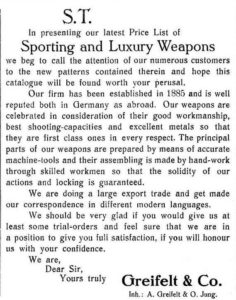 Friedrich Wilhelm Greifelt and the businessman Albert Emil Schlegelmilch. In 1891 the gun making shops were enlarged, and in 1902 Alfred Greifelt and Oskar Jung were in charge of the company. An office building was added in 1903. With the addition of a machine shop in 1917 the company was now among the largest mid-sized companies in Suhl. All this shows that the Greifelt Company evolved over the years into a major gun company that celebrated their 50 year anniversary in 1935, but in 1948, only 13 years later, the company was taken over by the Communist DDR Government in the divided Germany.
Friedrich Wilhelm Greifelt and the businessman Albert Emil Schlegelmilch. In 1891 the gun making shops were enlarged, and in 1902 Alfred Greifelt and Oskar Jung were in charge of the company. An office building was added in 1903. With the addition of a machine shop in 1917 the company was now among the largest mid-sized companies in Suhl. All this shows that the Greifelt Company evolved over the years into a major gun company that celebrated their 50 year anniversary in 1935, but in 1948, only 13 years later, the company was taken over by the Communist DDR Government in the divided Germany.
The word GREIF combined with the image of a bird became the trademark of the company in 1922.
Before and during World War II the Greifelt Company produced various components for the war 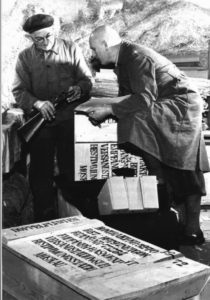 efforts but apparently did not produce any complete military guns. Records show that the company made a surprisingly great number of hunting guns for the civilian market during the war. Like other major companies in Suhl, Greifelt employed a considerable number of foreign workers from the eastern occupied countries, including women.
efforts but apparently did not produce any complete military guns. Records show that the company made a surprisingly great number of hunting guns for the civilian market during the war. Like other major companies in Suhl, Greifelt employed a considerable number of foreign workers from the eastern occupied countries, including women.
When Russian troops replaced the American troops in 1945 all manufacturing had come to an end and the future looked bleak. Only 38 employees of the Greifelt Company made kitchen utensils and other useful items and others cut firewood in the forests, but by the end of the year the company employed 94 men and in April of 1946 guns were made again in addition to measuring tools. From June 1946 to May 1947 the company was managed by Alfred Greifelt under control of the Russian occupation forces. Many changes in management followed until the company became a Volkseigner Betrieb, a company “owned by the people” under a Communist Government.
Between 1947 and 1948 the company was ordered to produce over 1000 hunting guns, increased  in 1949. to 1500, as war reparation to Russia. Greifelt hunting guns were exhibited at the 1949 Leipzig Trade Fair for the first time, opening the way for export to other countries. All this was achieved despite shortages of material and supplies, electricity outages and men ordered to mine Uranium in a nearby mine for use in the Soviet effort to build an atom bomb.
in 1949. to 1500, as war reparation to Russia. Greifelt hunting guns were exhibited at the 1949 Leipzig Trade Fair for the first time, opening the way for export to other countries. All this was achieved despite shortages of material and supplies, electricity outages and men ordered to mine Uranium in a nearby mine for use in the Soviet effort to build an atom bomb.
All large and medium size companies were now under the control of the government, and even the small gun shops were united in the government controlled Bühag. Under trying circumstances many good hunting guns were made during this time, Greifelt guns among them and still marked with 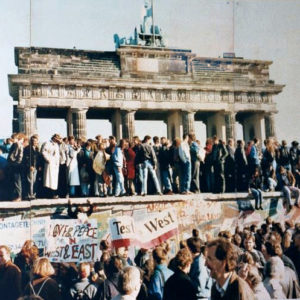 the Greifelt name. But many of the best craftsmen and business managers left East Germany when the border with West Germany was still porous border, and after the Berlin Wall went up in 1961 by way of the divided and blockaded Berlin and the Luftbrücke, the Airlift by American and British airplanes. During those years 3.5 million East German residents escaped to the West, among them Fritz Greifelt.
the Greifelt name. But many of the best craftsmen and business managers left East Germany when the border with West Germany was still porous border, and after the Berlin Wall went up in 1961 by way of the divided and blockaded Berlin and the Luftbrücke, the Airlift by American and British airplanes. During those years 3.5 million East German residents escaped to the West, among them Fritz Greifelt.
In 1989 the Wall came down, driven by a popular uprising, and the Communist Government collapsed. Germany was officially re-united in 1990. The free world and most East Germany citizens rejoiced, but hard times followed because the economy of East Germany collapsed. The export to the eastern countries came to an end and the companies could not compete with those in the west and the free world. All the disowned gun companies in Suhl, as well as most other companies all over East Germany, were now controlled by the Treuhand, a Government Agency that was given the duty to find buyers for all these companies that would prevent their total collapse. This effort stretched over many years with very mixed results. The only bigger company that survived in Suhlwas the Merkel Company, and this company also changed hands several times.
Greifelt guns made in Suhl are appreciated by the owners of the guns that survived the confiscation of all guns by American, British and Russian troops as soon as they entered a community. Many were destroyed right away, but others were brought home by soldiers who were allowed to keep two guns for their personal use. Many German hunting guns came to America this way and are now increasingly valuable, but many German guns were also exported to America before the two World Wars, and one can never be sure whether a gun was brought home from the war or was imported, among them the guns made by Greifelt.
The catalog pages in our Archive (Nr.74-T) will show you that Greifelt made many different types and models, including over and under and side by side shotguns, double rifles, Drillings, combination guns, stalking rifles and guns with the Heeren Action and the Clamshell Actions. The factory buildings shown on the cover of the Greifelt catalog look bigger than the actual buildings, but Greifelt had impressive facilities, well trained gun makers and a very good reputation.
The photo on the right shows the side of a Greifelt action on a gun that just came to our attention. It is a 410 Ga, over and under shotgun that is without a doubt a very rare gun. The flat surfaces on both sides of the standing breech all had elaborate deep relief engraving, and they can be considered the branding of Greifelt over and under guns.

More photos of Greifelt guns with very fine engraving can be seen in our Archive (Nr.40-PG)
Carl Gründig in Dresden (ca.1852-1913)
Gunmaker – Inventor – Gun Dealer
His sons:
Max Gründig – Hugo Gründig
Carl Gründig served an apprenticeship as a gun maker, became a Master Gun Maker in 1876 and opened his own shop shortly thereafter.
opened his own shop shortly thereafter.
He was appointed as Königlich Sächsischer Hofbüchsenmacher to the Royal Saxonian Court by his Majesties Albert (1873-1903), Georg (1902-1904) and Friedrich Augusr III (1904-1918). Thereafter his letterhead only listed the title Hofbüchsenmacher. Carl Gründig passed away in 1913.
Although the titles were purchased with a yearly fee and also depended on the right political connections, it gave him prestige and attracted a prominent clientele. Dresden was the capital and Crown City of Saxonia and had attracted many Gun Makers since the founding of a Gun Makers Guild in 1545, among them gun makers from Suhl. Some of the 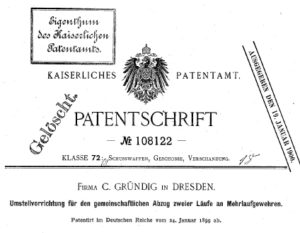 finest guns made in Suhl were made for the Court in Dresden.
finest guns made in Suhl were made for the Court in Dresden.
In the early years Gründig bought machined gun components made in Belgium and also in Suhlbecause he did not have the machines to do it himself. He must have also ordered completely finished guns and had his name engraved on them. At the end of the photo gallery we show a gun that has Suhl proof marks used since 1912. It also is stamped with a K that was the mark of a Kelber barrel maker in Suhl.
In 1916 the company became the representative for Saxonia of the Gunmakers Teschner and 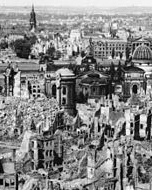 Collath. After Word War I (1914-18) the two sons continued the business mostly as a retail store and a shop to service the guns they ordered and sold. The business existed until early in February 1945 when Dresden was bombed by British and American planes that resulted in a firestorm that killed over 22,000 people and left the whole city in ruins.
Collath. After Word War I (1914-18) the two sons continued the business mostly as a retail store and a shop to service the guns they ordered and sold. The business existed until early in February 1945 when Dresden was bombed by British and American planes that resulted in a firestorm that killed over 22,000 people and left the whole city in ruins.
Two articles with photos of fine Gründig guns, additional information and patents of his inventions are in our Archive (Nr.59-PG).
Hagn Rifles and Actions
P.O. Box 444 Station Main
Cranbrook, British Columbia V1C4H9
Canada
Tel. 250-489-4861Hagnrifles@live.comMartin Hagn is a German Master Gunsmith who had his own business in Germany but now has his shop in Canada. He builds best quality rifles to order.An article about Martin Hagn and his shop can be found in our Archive.The single shot action shown above was designed by Martin Hagn in cooperation with Hartmann & Weiss who are producing the action, use it for their own rifles but also for Martin Hagn who now has his own gun shop in Cranbrook, British Columbia.An article about Hartmann & Weiss can also be found in our Archive.
Hartmann & Weiss GmbH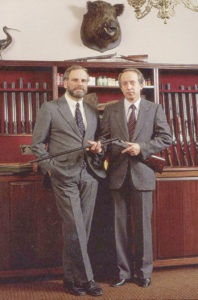
Rahlstedter Bahnhofstr. 47
22143 Hamburg Germany
Phone: 49 (40) 677 5585
Fax: 49 (40) 677 5592
info@hartmannandweiss.com
www.hartmannandweiss.comThe guns made by these two German Master Gunmakers are made to order and ranked with the Best London Guns. You can see their work at the Safari Club International annual show and at the IWA show in Nuernberg, Germany. An article about them appeared in a Journal of the German Gun Collectors Association, and you find it in our Archive.
Heym
Gun Makers in Suhl, Münnerstadt and Gleichamberg
The lists of gun makers in Suhl with the last name Heym is quite long. In 1835 the list shows 16 Heyms that worked on guns, and in 1895 it grew to 25 men, most of them gunsmiths, two stock makers and one “Einsetzer” who hardened the actions.
We only have information about a few of them, among them the maker of a Pinfire Gun, Max Heym who specialized in making rifles with Heeren Actions and the engravers August Heym and Joachim Heym who to this day still engraves guns in Suhl. But the most prominent one was Friedrich Wilhelm Heym
You can see the 1895 list of Heym gun makers and all those who worked on guns and also what little information we have at this time about a few of them in our Archive (Nr.68-T).
The Friedrich Wilhelm Heym Company
was founded in 1865 in Suhl
The Friedrich Wilhelm Heym Company is one of the very few companies that survived the first World War, the great depression, the Hitler years, the second World War and the American and Russian occupation, but not in the original location, but in two new locations under several Heym family members and finally a few new owners. The Heym name is still respected and Heym guns are appreciated to this day
The Friedrich Wilhelm Heym Company began in the building shown on the right in 1865 until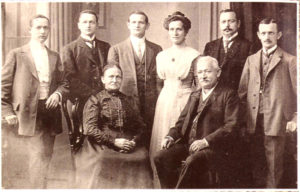 itclosed their doors at the end of World War II in April 1945 when American troops occupied Suhl and Russian Troops took over three months later. The founder had set the goal for himself and his company to be among the best gun makers in Suhl.
itclosed their doors at the end of World War II in April 1945 when American troops occupied Suhl and Russian Troops took over three months later. The founder had set the goal for himself and his company to be among the best gun makers in Suhl.
The founding of this company took place at a very 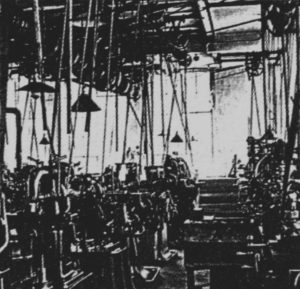 opportune time that was praised as the “Golden Years of Gun Making”. Breech loading guns had completely taken over from the muzzleloaders, percussion caps and back-action locks with outside hammers had also taken over, bringing about the first really practical hunting guns that were used not only by the privileged ruling class but by many ordinary people. Fulminates in percussion caps, in needle fire cartridges and finally in primers that ignited the powder inside brass cartridge cases had been invented, and center fire side by side double guns were now readily available.
opportune time that was praised as the “Golden Years of Gun Making”. Breech loading guns had completely taken over from the muzzleloaders, percussion caps and back-action locks with outside hammers had also taken over, bringing about the first really practical hunting guns that were used not only by the privileged ruling class but by many ordinary people. Fulminates in percussion caps, in needle fire cartridges and finally in primers that ignited the powder inside brass cartridge cases had been invented, and center fire side by side double guns were now readily available.
Three barrel hammer guns followed and various selector mechanisms that allowed the use of the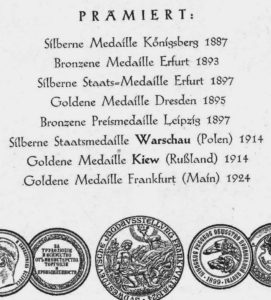 hammer on the right to fire both the right upper barrel as well as the third barrel below were invented in short order. But the “hammerless” actions, where the hammers were located inside the action or covered by the stock, had still to be invented. Heym was one of the very first companies to make a hammerless Drilling that had three triggers. The front trigger was hinged and could easily be pushed forward to reach the second trigger.
hammer on the right to fire both the right upper barrel as well as the third barrel below were invented in short order. But the “hammerless” actions, where the hammers were located inside the action or covered by the stock, had still to be invented. Heym was one of the very first companies to make a hammerless Drilling that had three triggers. The front trigger was hinged and could easily be pushed forward to reach the second trigger.
Patent Nr. 60215 for a Drilling with three triggers was issued to Heym on May 24, 1891. You can find an article about this patent and other interesting information in our Archive (Nr.35-PG).
The Heym catalog pages from the early 1920s show the great variety of models the Heym Company made and still shows hammer Drillings and also the first patented hammerless Drilling with three triggers. You will find it in our Archive (Nr.64-T).
Adolf Heym assumed the management of the Heym Company in 1912 and opened up good sales connections in Russia.
August Heym took over the management of the Heym Company in 1920 and began using Anson & Deeley type box lock actions on many of their models. Heym was also making some of the “Prussian Daly Guns” that the gun maker Lindner in Suhl had made up to the beginning of the first World War.
As all major manufacturers in Suhl, Heym must have also made components for the war production but to the best of our knowledge did not make any complete military guns. You will find the story about the arrival of American troops in Suhl in our Archive (Nr.70-T).
A few of the bigger gun makers in Suhl left with the American troops when they pulled out and Russian troops occupied Suhl. The explanation why the Heyms left Suhl after Russian troops took over from the American troops was found in an old article whose author is not 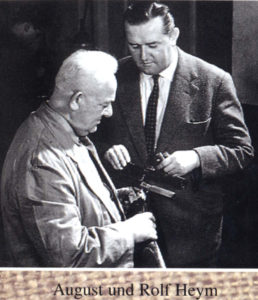 known to us, and you can read it in our Archive (Nr.69-T).
known to us, and you can read it in our Archive (Nr.69-T).
August and Rolf Heym started a new Heym factory in Ostheim located in the American zone of the divided Germany. Since the ownership and making of guns was not yet allowed, they made various other products like cuckoo clocks, spinning wheels and slide rules. They then had the opportunity to make a new Mauser-Heym bolt action police carbine, one of the first guns to be permitted by the American and British allies.
By 1952 the revised laws again allowed the ownership and making of certain hunting and sporting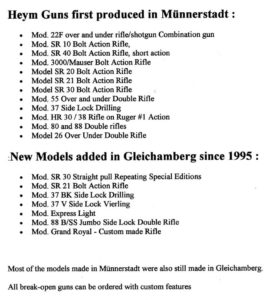 guns, and a new factory was built in Münnerstadt, close to the iron curtain that separated the two parts of Germany. Very early on they purchased one of the first available cold hammer forging machines for the making of shotgun and rifle barrels, and they began selling barrels to other gun manufacturers.
guns, and a new factory was built in Münnerstadt, close to the iron curtain that separated the two parts of Germany. Very early on they purchased one of the first available cold hammer forging machines for the making of shotgun and rifle barrels, and they began selling barrels to other gun manufacturers.
The list of gun models that were developed in Münnerstadt and those that were added after the move to Gleichamberg is shown on the right and can be enlarged. Only very few guns that are listed were discontinued or superseded by improved and upgraded models.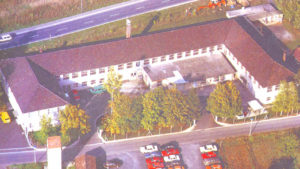
Photos of the Heym factory in Münnerstadt and of some of the guns that were made there and others that found their way to the USA and are shown on auction catalog pages can be seen in our Archive (Nr.36-PG)
Rolf Heym took over the management of the Heym Company from 1963 up to his death in 1972.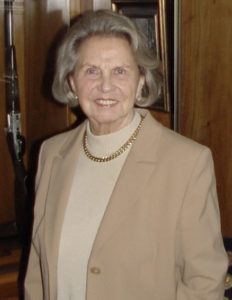 At this time Elisabeth Heym took over the management of the company together with her husband, Hubert Dschulnig. Peter Bang became the plant manager, and it was he who appointed Paul Jaeger, Inc. in Jenkintown, Pennsylvania as the importer of Heym guns in the USA. The Heym SR20Bolt Action Rifle was of interest to left hand shooters because the rifle was available with a true left hand action and the rifles were available with a classic straight comb stock that was at that time still preferred by many.
At this time Elisabeth Heym took over the management of the company together with her husband, Hubert Dschulnig. Peter Bang became the plant manager, and it was he who appointed Paul Jaeger, Inc. in Jenkintown, Pennsylvania as the importer of Heym guns in the USA. The Heym SR20Bolt Action Rifle was of interest to left hand shooters because the rifle was available with a true left hand action and the rifles were available with a classic straight comb stock that was at that time still preferred by many.
At the urging of the Jaeger Company and of Tom Turpin, who had a close relationship with Heym when he was stationed in Germany, the Model 88-B Double Rifle and the Model 88-BSS Side-lock rifle became available early in the 1980s, one of the first affordable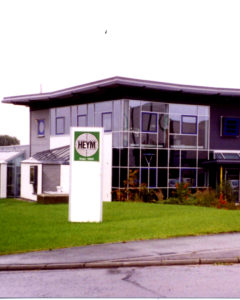 magnum caliber double rifles for most dangerous game hunters, lower priced than the Chapuis Double Rifles made in France and ahead of the Krieghoff Double Rifles made in Germany.
magnum caliber double rifles for most dangerous game hunters, lower priced than the Chapuis Double Rifles made in France and ahead of the Krieghoff Double Rifles made in Germany.
The story of a Model 88 BSS rifle, the Nr.3 Buffalo Double Rifle made by Heym for the “Safari Club International’s Big Five Rifles” is told in the limited edition book “Safari Club International” by Bill Quimby and in a feature article in German from a German gun magazine. The German article explains the unusual circumstances how the Canadian high bidder lost his rifle that is now in the possession of the “Canadian Mounties.”
Thanks to the kind permission from Safari Club International and from the German hunting magazine Wild und Hund, you can find information about both in Section 15 and the two articles in our Archive (Nr.65-T).
In 1992 a new owner in Switzerland bought the company that was then taken over by a new owner in Munich who took advantage of the unification of Germany and the financial support by the German government to re-vitalize the East German economy. A new factory was built in Gleichamberg, and the Heym Company moved there in 1995. Gleichamberg is a small village that is barely inside the former Russian occupation zone that was the DDR (Deutsche Demokratische Republik) under a Communist Government. The factory is located about half way between Münnerstadt and Suhl, where Heym was originally located. The Heym employees could be taken by bus from Münnerstadt to the new location, and Suhl gun makers could also commute to the new factory. Most likely all new Heym guns are now proof tested in the proof house in Suhl.
Photos of Heym guns custom options made in Gleichamberg, including an exquisite side lock double rifle, can be seen in our Archive (Nr.37-PG).
On February 1, 1998 Thomas Wolkmann became the owner of the company who once again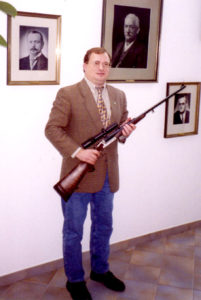 opened former markets in Russia and other former Communist countries. Under his leadership the company directed most their efforts to making fine custom built guns with many option, like action types, barrel configuration, fine wood and fine engravings. An interested buyer can visit the factory and discuss all details of a gun he wants to order and even meet the engraver who will do the engraving to his expectations. The company now seems to have found its niche in the world market and seems to be firmly anchored.
opened former markets in Russia and other former Communist countries. Under his leadership the company directed most their efforts to making fine custom built guns with many option, like action types, barrel configuration, fine wood and fine engravings. An interested buyer can visit the factory and discuss all details of a gun he wants to order and even meet the engraver who will do the engraving to his expectations. The company now seems to have found its niche in the world market and seems to be firmly anchored.
Members of the German Gun Collectors Association visited the new factory in Gleichamberg and photos of the visit, giving you a good idea of the modern facilities and machines, are in our Archive (Nr.39-PG).
Franz Jaeger (Jäger) 1876 – 1957
F. Jäger & Co. used the Trade Mark “Herold”
Master Gunsmith – Manufacturer – Inventor
Friesenstr. 17 (formerly Pfiffergrube).
Suhl – Thuringia – Germany
Franz Jaeger served an apprenticeship in Zella-Mehlis and shortly thereafter went to America. He worked for several companies in New York City, and then opened Bittiner & Jaeger with a partner,a business located on Broadway. He advertised the installation of selective single triggers into existing guns. He got married in New York and his first son Paul was born there. He then returned with his family to Germany and started his own business in Suhl. An Almanac about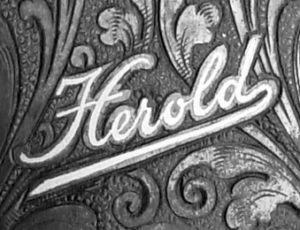 Franz Jaeger, his company, his inventions and his life is in preparation and will be offered when the time comes.
Franz Jaeger, his company, his inventions and his life is in preparation and will be offered when the time comes.
You will find a good part of the story and more information in our Archive.
Kurt Jaeger (Jäger)
Gunsmith – Businessman
Suhl and Mainz, Germany
Wiesbaden Rod & Gun Club
The Kurt Jaeger name is known to American gun collectors, but many think that he was a gun engraver. He was not, but he was from the old school when only the name of the gun business was found on a gun, never the name of the engraver. Kurt Jaeger had engravings done by Emil Willig, his son Claus Willig, both in Schweinfurt, The engraver Schildbach left Zella_Mehlis before the wall went up, worked first for the Wiesbaden Rod and Gun Club of the American Air Force and then at the Jaeger shop in Mainz.
Kurt Jaeger and his family had left Suhl, the former German gun making center, before the wall went up, and opened his own gun business together with Dietrich Apel in Mainz. This was a time when Germans were still not allowed to have guns, and American Servicemen were the only customers in the beginning. Kurt Jaeger also managed the shop of the Wiesbaden Rod & Gun Club for a while. The work consisted mostly of custom built bolt action rifles, scope mounting, repairs and many engravings done by the three engravers. An Almanac about Kurt Jaeger is in preparation, and will offer it in this website when the time comes.
You will find a very interesting article about an AyA shotgun that Kurt Jaeger had engraved by 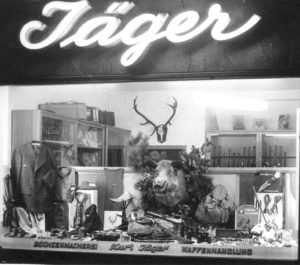 Emil Willig in our Archive (Nr. 118-T).
Emil Willig in our Archive (Nr. 118-T).
For more information, see our. Archive
Paul Jaeger, Gunsmith, Inventor
Manufacturer Dealer and Importer
Jenkintown, Pa. U.S.A
Paul Jaeger was born in New York City where his father worked as a gunsmith and founded his own company, Bittiner & Jaeger, on Broadway.
With his parents Paul returned to Germany as a baby, and he grew up in Suhl in his fathers house and gun factory. After graduation he served an apprenticeship and went on to an engineering school. When a lost war brought hard times and the German economy had stagnated into a recession, he returned to New York City in 1927. Since he was an American citizen by birth he did not have to wait for a visa. He worked for several gun related companies in New York and moved to Philadelphia a few years later. He had established a gun shop in Jenkintown which borders on Philadelphia. He converted it to a machine shop during World War II and was part of the war production. When World War II ended he right away established a hunting and sporting goods retail store, expanded the gun shop and produced accessories for hunting rifles that became very popular, as well as the Jaeger Sporting rifles in four grades.
For additional information, see our Archive.


